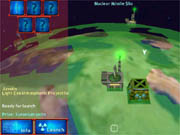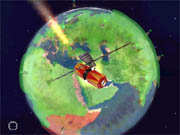Set in the year 2040, MAD brings the world's nuclear nightmare to life. Advanced satellite defense systems orbit over arsenals of nuclear warheads just waiting for new targets. Dubbed an "arcade strategy game" by its designers, MAD (mutually assured destruction) combines a basic real-time strategy formula with some first-person action. While the real-time strategy elements will be immediately familiar to fans of the genre, MAD is probably more reminiscent of classic board games, because of its simple dynamics, and of classic arcade games, because of its hectic pace.

The game divides the globe into 16 territories, split between you and the computer or between you and another player. Your goal is to annihilate all enemy territories with nuclear weapons before you're met with the same fate. Each territory produces two resources to power your way to victory: The first of these is cash, which lets you build missile silos and launch pads on the ground and put space station modules into orbit over each territory. These stations provide research facilities for developing new technologies, and they act as orbital defense platforms bristling with rockets and beam weapons for intercepting enemy missiles. Research is divided into seven basic categories like nuclear missiles, kinetic weapon research, or commercial applications to garner more cash. Your other resource is uranium, used to launch missiles. MAD plays so quickly that you're unlikely to get a lot of research done or have to worry much about resource balancing before the game is over.
To manage your territories, structures, and research, you're presented with ground-level and low-orbit views of the earth. You'll find yourself frequently switching between both views, since you need to see your structures directly to access their functions. To help with this management, you're presented with a minimap, though its small scale at higher resolutions lessens its usefulness. What's more useful is the readout that lists your territories along with icons showing what structures you have in each of them and what station modules orbit above them. With this readout, you can jump directly to the structure or module you want by clicking the appropriate icon.
This is particularly important for quickly accessing your defensive systems. While they work independently, they're somewhat more effective when you operate them manually in first-person view. This arcade-style element helps spice up gameplay, but it's a bit difficult to aim the guns because of the high and nonadjustable mouse sensitivity. You also manually target your nuclear missiles, but illogically enough, the more quickly you aim and fire, the more accurate the strikes are. The accuracy doesn't really matter much anyway since you only need to be roughly near the target. The whole feature seems superfluous.

It's also difficult to keep track of each territory's remaining strength percentage. You can see it when you move the cursor over a territory in the orbital view, but it would be much easier if these percentages were indicated all together in one of the interface panels. Fortunately, most other information is readily available through text warnings at the bottom of the screen when an important event occurs, coupled with an appropriate sound effect.
While these sound effects aren't numerous, they're colorful and set the mood well. Rumbling missile launches, wailing air-raid sirens, and static-distorted voices from mission control are lively and memorable. However, the sounds can quickly become repetitive when the action heats up, since each event seems to use the same effect over and over. The musical score is also sparse, but the appealing symphonic tracks are appropriately grandiose.
MAD's visuals aren't stellar, but they have a certain charm. The menu interface uses a blocky, old-fashioned computer font, and the graphics as a whole have a nostalgic, cartoonlike look. In some ways, this throwback visual style is appropriate to the game's material, which seems as if it came out of the late Cold War.
In fact, MAD seems to be something of a spiritual descendant of the early arcade classic Missile Command. There's a clear emphasis on action, not merely through the manually targeted weapons but through the basic gameplay. You'll have to work extremely quickly to win as you rapidly jump between viewpoints, which can detract from the game's strategic elements. These are fairly limited from the start, despite 10 scenarios of varying difficulty levels that start you with different numbers of territories, structures, and so forth. Still, if you don't approach it like a sophisticated real-time strategy game or full-fledged action game but more like a fast-paced computerized board game, MAD can be a fun diversion.